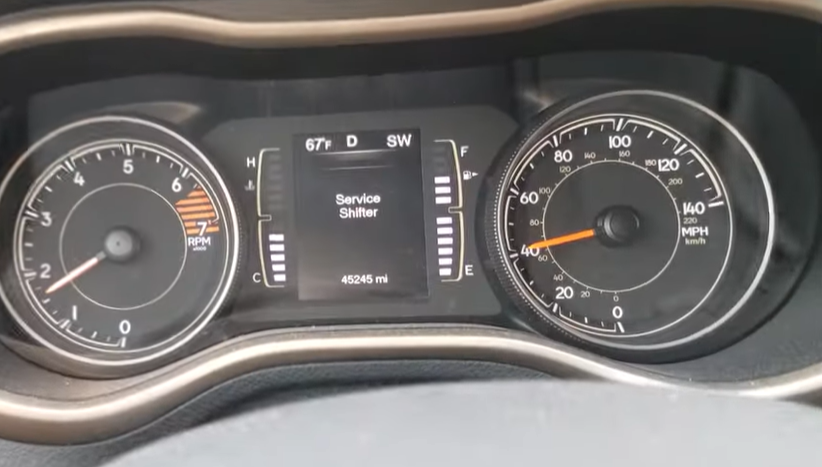Jeep Cherokee Service Shifter Light On (Troubleshooting Guide)
The “Service Shifter” message on a Jeep Cherokee means the vehicle has detected a fault in the shifter or related systems. The dashboard will show the message and the shifter LEDs may all light up. The fault can be simple, like a blown fuse, or more complex, like a faulty shift position sensor or module. This guide covers quick checks, step-by-step diagnostics, common fixes, specific model-year items, safety advice, and the exact actions a mechanic will take.
Quick summary
- Check fuses first. A blown fuse is the fastest fix.
- Scan the car with an OBD-II scanner to capture codes and freeze frame data.
- Inspect shifter wiring and connectors. Re-seat or clean any corroded pins.
- Try a soft reset: key cycle or battery disconnect to clear temporary software faults.
- Look for specific codes like P1C86 or U1465 on some model years; these often point to shifter module or connection issues.
- If wiring and fuses are fine, update the vehicle software or evaluate the shifter assembly and transmission control module.
- For complex repairs, take the vehicle to a dealer or qualified shop. Some fixes require special tools and dealer software updates.
What “Service Shifter” actually means
The message is the vehicle telling you that the electronic shifter system is not reporting expected values to the powertrain control modules. The shifter assembly, the transmission range sensor, control modules, wiring and the fuse box are all part of that circuit. The same fault label can cover simple mechanical problems, electrical issues, or a software glitch. That is why the diagnostic steps start simple and escalate only when needed.

Common causes and how to check each one
1. Blown fuse or weak power supply
Why it matters. The shifter and its control electronics rely on fuses and stable voltage. A blown fuse or weak supply makes the module lose communication and triggers the message.
How to check. Locate the appropriate fuse in the fuse box, inspect it visually, and test it with a multimeter. Replace with the exact amperage fuse when needed. Keep spare fuses in the glove box for quick troubleshooting.
2. Wiring, chafed harness, or corroded connector
Why it matters. Vibration, heat cycles, and road debris cause wiring damage. A loose or corroded connector at the shifter or at the transmission control module will interrupt signal flow.
How to check. With the vehicle off, inspect the shifter harness along its routing. Look for broken insulation, pinching, or melted sections. Unplug the shifter connector, check for bent pins, corrosion, or water ingress, then re-seat it firmly. If you find damaged wires, repair using solder and heat shrink or replace the harness section.
3. Faulty shifter position sensor or shifter assembly
Why it matters. The shifter position sensor tells the vehicle which gear is selected. If it fails the car may lose manual shift selection or disable certain functions.
How to check. Use a scanner to read position sensors and compare reported gear with physical selector. If the module reports erratic values, replace the sensor or shifter assembly. On many Cherokees the sensor is part of the shifter housing.
4. Shift solenoids and transmission internal faults
Why it matters. If the transmission cannot confirm gear selection, the shifter message may appear because the system cannot safely control or detect gear state.
How to check. Scanners that read transmission codes and live data will show solenoid failures or pressure anomalies. If internal transmission faults are present, the repair will likely need a transmission shop.
5. Transmission Control Module (TCM) or Body Control Module communication
Why it matters. The shifter system is a networked system. Communication errors or module faults between the TCM, BCM and instrument cluster will create the shifter fault.
How to check. Perform a full scan to capture U-codes or module communication errors. Check wiring to the TCM and body module, and note whether other modules show errors. Re-flashing the module software can resolve communication bugs.
6. Software bug or required software update
Why it matters. Some Cherokees have known software quirks where a calibration or update is necessary. A software update can resolve intermittent or temperature-dependent faults.
How to check. If wiring and hardware test clean, contact a dealer for a software scan and available updates. Dealers have factory-level tools to update calibrations. For software-related symptoms and general guidance, see a consolidated cause list including software problems: Jeep Cherokee Service Shifter Light On.
7. Shifter bezel, bracket, or mechanical interference
Why it matters. A loose bezel or bracket can move the shifter relative to its sensor. That causes calibration problems and unexpected sensor readings.
How to check. Inspect the plastic bezel and mounting bolts. Tighten or replace broken clips. If the shifter feels loose or knocks when you move it, service the mechanical mount.
8. Brake light circuit interlock
Why it matters. The brake pedal switch confirms that you are allowed to shift out of park. If the brake light circuit is faulty, the shifter may be put into a protective state, triggering the message.
How to check. Verify brake lights work when you press the pedal. Check the brake switch and its connector for continuity and proper voltage. Replace the switch if it is out of specification.
Symptoms to expect when the light appears
- Dashboard displays “Service Shifter” and the message will not clear with simple button presses.
- All shifter indicator LEDs may illuminate simultaneously.
- Manual shift or sport-shift mode may be disabled.
- Vehicle may still move in Drive or Reverse but shifting could be limited.
- Problem can appear randomly, often on cold starts, while components heat up, or after hitting bumps. This timing pattern is reported by several owners and video diagnostics demonstrate the random cold-morning and bump-related triggers.
Step-by-step diagnostic checklist (practical and ordered)
- Capture codes. Connect an OBD-II scanner that reads body and transmission modules. Record stored and pending codes and live data. Look for U-codes and P-codes related to shifter or TCM.
- Visual and basic checks. Turn the key off. Inspect the shifter area for physical damage. Check fuses and replace any blown fuses with the correct rating.
- Check brake interlock. Verify brake lights illuminate and test brake switch continuity.
- Reseat connectors. Unplug and plug back the shifter harness and connectors to the TCM and BCM. Use dielectric grease on pins after ensuring they are clean.
- Battery and soft reset. Perform a soft reset with a key cycle. If that fails, disconnect the negative battery terminal for 10 to 15 minutes to clear transient errors. Reconnect and re-scan.
- Inspect wiring. Follow the harness visually. Repair chafed wires. Use a multimeter to check for continuity between the shifter and control module pins where applicable.
- Evaluate module communication. If scanner shows module communication faults, note the specific modules and U-codes. Reprogramming or replacement may be required.
- Replace suspect hardware. If the shifter sensor or assembly tests bad, replace it. If codes indicate TCM faults, consult a transmission specialist for replacement or re-flash.
- Software update. If hardware checks out, ask the dealer for the latest calibration and flash. Factory tools and updates are sometimes necessary to cure persistent faults.
Specific model-year notes and known fixes
Cherokees from 2014 to early 2015 and later models have reported recurring service shifter messages. Some owners and technicians found a remedy by accessing a deep connector on the shifter assembly and replacing or reseating related components. That hands-on repair is documented in diagnostic videos that show code examples like P1C86 and U1465 and a physical connector fix. If you have a 2014 or early 2015 model, share these codes with your mechanic.
Tools, parts, and time estimates
- Tools: OBD-II scanner with body and transmission support, basic hand tools, multimeter, dielectric grease, soldering kit and heat shrink for wiring repairs.
- Common parts: fuses ($2 to $10), shifter sensor or bezel ($150 to $600 depending on assembly), harness repair materials ($20 to $150), TCM replacement ($600 to $1,500), dealer software update (usually shop time $50 to $150; dealer labor rates vary).
- Time: basic checks 15 to 60 minutes, wiring repairs 1 to 3 hours, module replacement 1 to 4 hours, full dealer diagnosis and reflash 1 to 2 hours.
When to seek professional help
- Vehicle enters limp mode or cannot be driven safely.
- OBD-II codes point to TCM failure or internal transmission problems.
- Uncomfortable doing electrical diagnostics or soldering.
- Shifter assembly replacement requires interior disassembly or dealer-only programming.
Safety and final checks
Never attempt repairs that leave the vehicle in an unpredictable state. If the shifter will not reliably select Park, or if the vehicle can roll when parked, tow it to a shop. After any repair, verify the brake interlock, shift lock and parking mechanism work correctly before driving.
Frequently Asked Questions
Why did the Service Shifter message appear randomly and then clear?
Intermittent faults are usually wiring or connector issues, or software glitches. Heat, cold and vibration can change connection resistance and make symptoms come and go. Follow the diagnostic checklist focusing on connectors and the power supply.
Can I drive with the Service Shifter light on?
Short drives may be possible, but shifting or manual modes may be disabled. If the vehicle behaves unpredictably, do not drive it. Park safely and get the car checked. Safety first.
Will a battery disconnect fix the problem?
A battery disconnect can clear temporary software faults and restore normal operation. If the fault returns, a deeper issue like wiring damage, a bad sensor, or required reprogramming exists.
Is this covered under warranty or a recall?
Coverage depends on your warranty, extended plans, and whether a technical service bulletin or recall exists for your VIN. Ask your dealer to check for open campaigns and TSBs during diagnosis.
What diagnostic codes should I report to a mechanic?
Report any P-codes and U-codes from the scan. Codes such as P1C86 or U1465 have been reported on affected Cherokees. Provide the mechanic with the full code list and freeze frame data for faster diagnosis. For an example of model-year specific codes and repair steps, see this owner-sourced repair walkthrough.
Can I replace the shifter myself?
Yes for competent DIYers who can remove interior trim and reconnect wiring. However, some replacements require calibration or module reconnection that may need dealer tools. If you are not comfortable with interior disassembly and wiring, have a shop perform the job.
How much will a dealer software update cost?
Costs vary by dealership labor rates. A reflash itself takes about 30 to 60 minutes of shop time. If a hardware part is required after the update, that will increase cost.
Are there any temporary workarounds?
Temporary fixes include replacing a fuse, reseating connectors, or performing a battery reset. These may restore operation temporarily but do not replace a proper repair.
Should I keep spare fuses in the car?
Yes. A blown fuse is a common and quick fix. Keep the correct amperage spare fuses and a small fuse tester or multimeter in the vehicle.
What if the shifter LEDs all light up but the vehicle still drives?
That indicates the electronics are detecting a fault but the transmission may still operate under a default state. Do the full diagnosis and scan for codes. Driving without resolution risks getting stranded if the fault worsens.
Fixing a Service Shifter message is a methodical process. Start with fuses, scans and connectors. Escalate to wiring, sensors, modules and dealer updates only after basic items are ruled out. If you need help interpreting codes or deciding next steps, bring scan results and symptom details to a qualified shop or dealer and act quickly to avoid being stranded or causing transmission damage.







